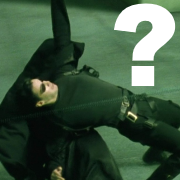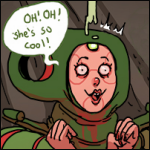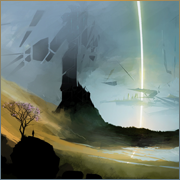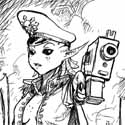- Kylaer
- Aug 4, 2007
-
I'm SURE walking around in a respirator at all times in an (even more) OPEN BIDENing society is definitely not a recipe for disaster and anyone that's not cool with getting harassed by CHUDs are cave dwellers. I've got good brain!
|
So this is the piece I wrote and posted back in October 2015. It's been a long time. I was a different person then, who had accomplished a lot less and also lost a lot less.
quote:Describe to me, Lord General, what you want in the background. You have time to think on it, plenty of time; I expect I'll need six or seven hours of you here in the studio, split over two, maybe three sessions. Good thing you don't need to hold still the whole time, eh? Getting all the details of your uniform coat done right, that's two hours of work by itself, not even including the medals. But the background, I can work on that after your centerpiece is done, so I want to make sure you're happy with the plan before I set to work.
What do I recommend? There's no one answer that's right for everyone. My most recent commemorative work like this was for a shipmaster, the sixth generation of a dynasty. I gave him a plain studio backdrape, folded cloth, neutral, enough details that it wasn't a void but not so many as to distract a viewer from the man himself. That painting hangs beside those of his forebears, and in that context, you want to highlight the individual and diminish everything else. I saw his ancestors' paintings before I started mine, and both his grandmother and great-great-grandfather chose the ship's command throne and dias as their setting. Too easy to let the paintings blur together in your mind afterwards, and isn't distinction the whole point of a commemorative? His father had some rather outlandish arrangement of him standing before an observation blister, showing a planet that was composed of slices of other planets, like a bizarre wheel - all ones that had been important in his life, I understand, but the eye was drawn towards the background and you only noticed the shipmaster himself as an afterthought. Now, you're the first one in your family to achieve such a high station, so you won't be comparing your painting to a gallery of others, so there isn't as much in the way of restriction, but it's still something to think about.
Feel free to move around. Sit, stand, whatever you wish. I've got drinks on the sideboard there, if you want something. If I need you to take a particular pose I'll let you know, but getting an understanding of how you move will help me with my painting. I'm not shooting picts or even scanning you for a hololith, after all; this is about depicting who you are, not just freezing an image of you. If a pict could do that, I wouldn't have a job any more, would I?
Do I paint battle scenes? Yes, I do, but a word of explanation before you choose a battle as your background. I paint best when I'm drawing on my own experiences, and I have never stood on a battlefield myself. So my scenes of warfare are more stylized than how you yourself will be painted, and the difference in styles may detract from the overall painting. Now, if you wanted a parade ground, or a strategium, those I can do true to life, but I've never heard the roar of the guns. The last officer of rank who I made a commemorative for chose the battle standard of his regiment as the background. That was a little more than a year ago. It was a distinctive but not too busy design, so it was a fine complement. Your regimental banner has the same color pattern as your uniform coat, so it's not as ideal a choice, I'd say.
The most recent military work I've painted? That's...well, that's a strange one, and in truth I can't say if it was military or something else. It was a tithe assignment I performed a couple of months ago; I have an arrangement with the governor's office and the Ecclesiarchy to pay my tithes in time spent working instead of money, and usually they'll have me do commemoratives for high officials, art for display in public buildings, that sort of thing. This time around, the liaison official told me that I had a special project, a request from very high up the hierarchy; someone, I don't know who, wanted me to do a series of murals at a monastery. It would be a six-week on-site project and would cover my tithe duties for the whole year.
"What's the name of the monastery?" I asked.
"Stillness," she replied.
I'd never heard of it. And apparently no-one else had, either; I tried doing some preliminary research before the project's start date, and could find no mention of such a monastery. I've done religious art before, of course, plenty of it, but I like having an idea of what style I'll be matching my works against; an M.39 Tayind-style mural wouldn't fit alongside M.36 Settlement-era works, not at all.
I arrived at the flyer port with my travel cases, and let me tell you, a six-week painting project requires a great deal of luggage. Sometimes I joke that I could use a military cargo lifter, but that day it proved to be no joke, for an Imperial Navy troop transport was waiting for me on the runway. A pair of crewmen shepherded a team of cargo servitors while a third led me to a passenger seat above the main bay, just behind the pilots' cabin. The crew were polite, but engaged in no small talk whatsoever, and I did not press them for it.
The most obvious difference between this military vessel and the crafts I routinely took transit on was the complete lack of windows. The seat was comfortable - probably meant for transporting officers like yourself, I'd guess - and the ride was smooth, but I had not the slightest idea where we were going. We flew for hours, and when the descent started, we could have been landing anywhere within several thousand kilometers of our origin.
Secrecy about the location is perfectly understandable, but I do wish they'd told me to dress warmly. We hadn't landed in a polar zone or anything that extreme, but when the ramp lowered, the air that gusted through had a distinct bite to it, and I'm old enough to notice these things.
Quick behind the realization that I was going to need heavier clothing came the dawning awareness that this was going to be a good project. I would not be short of inspiration.
Past the edges of the ferrocrete landing strip, the land was covered in vibrant greenery. No high-reaching trees like the tropics, but grasses and wiry evergreens aplenty. Not far away, half a kilometer at most, the contour of the terrain grew broken and turned sharply skyward, rising to a snow-capped peak, and as I reached the ground and looked around me, I saw that it was just one of many such peaks surrounding us. We were in a high mountain valley, the landing field at the low end of its oblong basin, and at the far end, two or three kilometers away, I saw what could only be the monastery that they called Stillness.
Oh yes. Inspiring indeed.
There were a few blocky, pre-fab support buildings clustered around the landing strip, and a pair of hangers, but past that blotch of modernism, the valley was idyllic. One road, curving back and forth as it rose towards the monastery, wide enough for four lanes of traffic but with not a single vehicle on it. Once the engines of the aircraft had spun down, I could hear nothing except the whispers of the wind. The greens of the valley, the greys and browns of the mountainsides, the white tops all around, and the sky that perfect shade of purple-blue that you simply don't see closer to the cities. I couldn't see much of the monastery itself yet, just the outlines of a few buildings, seemingly carved of white stone, but the feeling had already settled into me that, in a setting like this, there was no chance it could have been built as anything less than magnificent.
And I was right, although not quite in the way I had expected.
We didn't take a vehicle to travel up the road. In fact, I saw no motor vehicles anywhere on the site. Instead, my luggage was loaded onto a pair of carts, which were hauled by teams of servitors. Thus, our approach was made at a slow walk, which gave me plenty of time to study the complex as it drew near. It was built of white stone, as I'd seen from afar, and sprawled over a considerable patch of ground. Low walls - shoulder height to me, less than that to you, hah - divided the space around and between the five principle buildings. It was spacious, the walking paths broad, but what caught me by surprise was that it was both less ornate and less populated than I expected. It was superbly constructed, every wall made of blocks of stone cut and polished to a glossy sheen, but austere, very little in the way of decoration at all; none of the rooflines bore ornamental spires, the eves were not populated with gargoyles, even the downspouts were plain tubes. There was a word engraved over the main gate, but it wasn't the name of the monastery - it was something in High Gothic that I didn't recognize.
An acolyte came out to meet us as we approached, and at the sight of him, the two Navy personnel who had been walking with me turned and headed back down the road, not saying a word.
"Walk in peace," he greeted me. He was a man my own age, which is to say his hair was nearly all grey, and he wore a loose robe of white cloth belted with a cord, over a similarly white insulated bodyglove. No decorations, no religious paraphenalia. His eyes were sharp, although his expression was open and friendly.
"May blessings rest upon this place," I replied. "I am here to do some painting, at the request of a benefactor unknown."
"I know," he replied, smiling. "People do not reach us unanticipated. I have seen some of your work, and I look forward to seeing what you create for us. Welcome to Stillness."
He led me into an office, as the servitors pulled the carts away to their ultimate destination. The inside of the building was warm, although as spare in its decoration as the outside. Very different from any of the typical Ecclesiarchy buildings I have visited.
"Artistically," he explained, "you will have free rein to do as you wish, as long as it has a theme of tranquility. Explore, find suitable locations, create what appeals to you. If you need assistance, we will provide it. However, while you are within the monastery, there are some very important principles you must follow."
I had expected as much; abbeys and monasteries tend to be worlds of their own, each with prohibitions and expectations. "By all means, please describe them to me."
"This institution and its staff exist to serve the needs of a very special group of devotees," the acolyte explained. "We provide them with conditions such that they can meditate and free their minds. We must never distract them from their contemplations. These are the ways of Stillness: to never move with haste, to never raise your voice, and to never initiate any kind of interaction with one of our devotees."
"Very reasonable," I said. "How will I know who the devotees are?"
"Oh, there will not be any mistaking them," the acolyte said, smiling again. "They will be the only people you encounter who aren't in our age range...among other distinctions."
We made a bit of small talk, I inquired about getting a few thermal bodygloves for myself, then we exchanged our farewells and I set to work. Even though the monastery had a distinct lack of visible timepieces - and, notably, no bell tower - inside my head, the clock was ticking. And so I wandered, sketch-slate and stylus at the ready, and began noting likely locations where my work would best fit. It's not just a matter of finding a flat space of wall, you know; those were abundant everywhere I looked. I had to find places where a mural would make sense, where it would compliment the nature of the buildings and spaces. In the mental timeline I had made of the project, I gave myself two days for searching out optimal locations. Once I had prioritized my sites, I would make concept sketches, then create as many of them as I could in the six-week span.
A large number of fine sites were to be found within the monastery. Some were within the buildings - each of the five contained meditation rooms, chapels, walking galleries, choir and music halls, as well as more mundane daily-living facilities, although each building was distinct in its layout and bore slight differences to the others. Outside the buildings, defined by the low walls, were gardens, both of foliage and of carefully smoothed beds of pebbles, several groves of trees, freestanding gazebos sized for one or a handful of occupants, and even a stand of anchorite poles, their platforms elevated perhaps six meters off the ground.
It was in the morning of my second day that I first encountered one of the devotees. The entire complex, I should note, was only sparsely populated; I think everyone within the monastery could have consolidated their daily affairs into one of the five buildings, but I gathered that the wide distribution was on purpose, not by accident.
I heard a faint rattling sound as I approached the portico to another garden, which was unusual. Outdoors, I had barely heard a sound except the rustle of the wind. I had already been walking slowly, mindful of the monastery's precepts, but I slowed further as I neared the source of the noise.
A man was smoothing the pebbles of the garden, using a long wooden T-shape like a rake without tines. And he was clearly not one of the acolytes. He wore the same white robe and bodyglove, but he was no elder; nor, I could see immediately, was he a normal human. His hairless scalp was pockmarked in several places with augmetic plugs, gleaming in the sunlight, and his proportions were subtly wrong, his muscles too well-developed to be natural, as if he was a stylized drawing come to life. He was moving in a spiral, smoothing the pebbles behind him to erase his own footprints, as he neared the center of the garden. Another figure was already there, seated cross-legged, a white-haired woman who was clearly an acolyte. She had a string of beads held in one hand, and as I stood and watched, she worked one bead through her fingers and let it fall to clack against the others. After a pause, another bead fell, as the man who was no acolyte continued his smoothing, now almost to the center. I kept watching. This was my first glimpse of a devotee, the ones for whom my work was directed, and I had much to learn about them.
The devotee reached the center, carefully placed his rake to one side, and lowered himself to sit facing the woman, matching her cross-legged posture. A bead fell, the click loud against the silence of the garden. The acolyte did not react to the presence of the devotee, continuing her steady telling of the beads. After another bead had fallen, the devotee reached into his robe and drew out his own set of beads. They sat, no movement save their breathing and the motions of their fingers, and when the next beads fell, their clicks were barely distinguishable as separate sounds.
It wasn't just the bead telling that was in unison, I realized as I continued to watch. The devotee was breathing in the same cadence as the acolyte, reflecting each movement like a mirror. To the limits of my eyes, the imitation seemed flawless.
I did not cross that garden. I turned back and found another route.
I saw another devotee that evening, this one a hulking figure whose only exposed skin was that of his hands, as he wore a robe with an over-large hood, which was pulled all the way forward so that the cloth obscured his face. He followed precisely three strides behind an acolyte who was spinning a paper prayer fan between his hands, making a low fluttering noise, which must have been a guide beacon.
As the days rolled on and I set to my work in earnest, I identified three different devotees. The first was the man I had initially seen in the rock garden; the rock gardens proved the places he was most likely to be found, sometimes tracing a design in the pebbles, sometimes wiping it clean and sitting in meditation. I saw him up on the anchorite poles, too, although not often, and he was the only devotee who seemed to care to ascend those structures and stare out across valley at the mountains around us. The second was the huge man - he was over two meters tall, and more muscular than a competitive strongman - who kept his face covered. His routine seemed to revolve around auditory and tactile meditation cues; several times I heard the tones of harmonic bowls being struck, and followed the sound to find him seated at the center of a music room, an acolyte tapping on the array of bowls lining the chamber. He also seemed to appreciate the green gardens, and I saw him often there, tending to the plants by touch, stroking each leaf on a branch and carefully plucking off the dead. The third devotee, I didn't encounter until I had been at the monastery for nearly a week. Unlike the others, she was a woman, although it took me several times of seeing her to realize it; she had the same bare scalp as the smaller of the two men, the same unnatural physique, so it was only the lines of her face that gave me a clue. A bit embarrassing that I didn't notice immediately, considering that having eyes trained to pick out such details is vital for my work. She seemed to have no favorite location, and there was no pattern to my encounters with her; she would pick a spot and sit, flanked by one or two of the acolytes, and stare off into space. Or perhaps at something within.
My murals spread. I created many of them during my time at the monastery, and nearly all of them were designed to give the appearance that the space continued further than it did. I painted desert plains and distant shores to compliment rock gardens, deep jungles and sun-dappled forests for the green spaces, cavernous halls fading into gloom indoors; sometimes with a religious touch, a bit of iconography here and there, but since the monastery itself eschewed such decorations, I kept them minimal. What the devotees wanted, as I saw it, was space, and I would give it to them. It was simple, satisfying work, and I spoke fewer words in those six weeks than...well, than I'm speaking to you now, in fact.
There was an incident, near the beginning of the fifth week. I was four meters up on a ladder in a pebble garden, painting the flank of one of the five buildings to look like the mountain that stood on its far side. I had my sketch-slate as a reference, balanced on the top step, and was holding my palette and brush, doing some fine embellishments to the mountain's snow-cap. I was working with my arm at full stretch, and that was a mistake. I should have moved the ladder. But you know how it is, I was almost done, another few brush-strokes and then I'd finish with the cap and move down. So I bumped my sketch-slate with my hip and knocked it off its perch. And as I saw it start to fall, by reflex I broke one of the monastery rules, and barked out a profane word. Loudly.
The female devotee was in the garden. She had been there since before I started my work that day, just sitting on a little circle of rug woven as a mandala. She didn't move, she made no noise, she had no interaction with the acolyte who accompanied her. After a few hours of work, I had all but forgotten she was there.
She caught my sketch-slate. One instant she was sitting perhaps ten meters away, and the next she was there, the slate in her hand. At that, I almost fell off the ladder, and clutched at it for dear life.
When I saw the devotee's eyes, falling off the ladder suddenly became a distant second source of fear. I've encountered and worked for dangerous people before - soldiers like yourself, professional prize-fighters, a few very rich individuals who I am sure did not come by the wealth without getting some blood on their hands. None of them had ever looked at me like this. The only eyes I'd ever seen like hers had belonged to a beast owned by one of those very rich individuals, an apex predator from some deathworld on the sector's outskirts - eyes full of hunger, and even more full of fury at that hunger being denied satiation. I'd been afraid of it even though we were separated by a portcullis of bars as thick as my arm, and turned down a handsome sum to paint the monster. And here was the same gaze, coming from what was nominally a human, with nothing at all between us for protection.
She stared, unblinking. I could barely breathe. She was unarmed, but considering how she was built and the speed at which she'd moved, I had no doubt she could kill me as quickly as she wished, weapons or no. I waited, and eventually those eyes shifted, glancing at the slate before returning to me.
"Yours," she said, and raised her hand so that the slate was within my reach. Her voice was hoarse and unsteady, and I wondered how long it had been since she had used it.
"Thank you," I replied, and took it, not knowing if I should apologize for my earlier transgression or not.
The devotee turned, and addressed her watchful acolyte, who now stood only a few paces away. "Soon. I am near ready." Then she pivoted and walked back, slowly, to her meditation mat.
The acolyte, lips bloodless above his beard, looked at me. "You are very lucky, master artisan. You almost triggered her. Please remain careful."
I felt very lucky indeed, and also very shaky. I stayed off ladders the rest of the day, and fleshed out concept sketches for two new murals instead of working further on my mountainscape.
Two days later, as I was working on a mural of a pond to accompany a green garden, she approached me again. She did not look at me, only at the painting. "Artist. I would ask you a favor."
"Yes, honored devotee? What can I do for you?"
"Put me here," she said, pointing one finger at a stone on the pond's edge. "A painting of me."
"Of course, anything you wish. Do you have a particular way you wish to be painted?"
"I lack the words. You must see who I am." She turned once more to her acolyte - companion? Minder? I am not sure exactly what role the acolytes played, and I doubt a single term could encapsulate their role anyway - and told him "It will be tonight. And he is to be there."
Communication may not have been the devotee's strong suit, but she made her point clear. And so, I was unsurprised when an acolyte approached me after dinner had concluded and told me that my presence was expected for a ceremony.
I was surprised, though, by what the ceremony consisted of.
My guide led me to a large chamber on the upper level of one of the buildings. It was oblong, and its vaulted ceiling was formed by the underside of the roof; it contained no furniture, no decoration, and like many of the rooms in the monastery seemed to have no purpose. I'd found it in my wanderings, early in the project, but written it off as a mural site, expecting that nobody would see anything I created there.
Now, the room was not empty. It held a dozen acolytes - and all three devotees, the first time I had seen them in proximity to one another. They sat in a triangle, well separated, each in their own posture; the smaller of the men cross-legged, the larger man squatting with knees tucked under his arms, and the woman with her feet folded beneath her, shins against the floor.
"He is here," the big devotee said. His back was to me, and he had not turned his head. His voice had a higher pitch than I would have expected, given his size, but it sounded just as unaccustomed to use as the woman's. His hood was down, and his scalp gleamed under the lights. "I am ready."
The smaller man didn't speak. Perhaps he couldn't speak. He instead tapped a knuckle against the floor, just once, and gave a nod.
As one, the devotees rose to their feet. The robes they wore tonight were different, still plain and white, but slit along the sides to accommodate movement. An acolyte approached each of them, and I felt my heart start to pound when I saw that they were carrying swords. Training swords of polished wood, straight-bladed and sized to be used in one hand, but these were no fencing foils. These were derived from swords meant for killing. The devotees accepted their swords, and the angles of the triangle shifted, as both men pivoted to face the devotee who had so terrified me.
"I have achieved stillness within," she said. "Let us prove it."
Still in unison, the devotees raised their blades in the classic salute, then bowed low. And as they straightened from their bows, the ceremony began.
I was expecting a repeat of the blinding speed the female devotee had shown in the garden. I was expecting to not even be able to follow the movements of the duelists, for my mortal eyes to see them only as blurs. I should have remembered the name of the monastery.
The devotees moved like flows of thick syrup. Their blades floated into attack stances more slowly than I draw a brush across canvas. I was reminded of a master I studied under during my training, who insisted that nothing was better for learning how people moved than to watch vids and hololith recordings taken in slow motion. His students spent hours watching people walk, run, dance, play sports, all sorts of activities, at one-fourth to sometimes as little as one-tenth speed. It was useful learning, although he was a little too enamored of it relative to its real benefit, I would say. Some of the recordings we watched were of fencing matches, and it was interesting to see the tiny mistakes that meant the difference between victory and defeat in a championship match.
This was like seeing one of those slow-motion matches come to life. This was not, let me assure you, any kind of stylized dance or set of predetermined movements. This was a fight, and I saw maneuvers I recognized from those long-ago recordings, parries and ripostes, carried out with consummate skill. And as they closed the distance, it became more than a sword duel, with body strikes and grappling maneuvers being incorporated. Blades clicked, separated, clicked again, long seconds ticking by between each meeting. There was not a tremble of a muscle anywhere, not a break in the cadence, even as they exchanged what would at full speed have been a staggering rain of blows.
What made my jaw drop was that they managed to fall in slow motion. The female devotee intentionally tossed her sword a couple of meters away - the arc described by the wooden blade was the only thing in the whole match that happened at normal speed - then grappled the smaller of the men, powering him off balance. I wish I could have recorded it, it was unbelievable, the way they balanced and braced each other such that their descent to the floor was no faster than any other movement they made. She turned the tackle into a roll, retrieving her sword on the way, and brushed the tip against his throat while she was still balanced on her shoulders, before he could recover his own blade into position. The small man went still as she completed the roll and rose to her feet, now facing only the larger man.
The duel had been going on for at least five minutes by that time. I suspect that unrestricted, it would have reached this point within a few seconds. As I watched them close for the second clash, I thought their fighting style wasn't really focused on their sword. They used their whole bodies, chiefly their off hands but also their knees, feet, and the edges of their forearms. They fought with everything they had, except their speed, and every movement they made was worthy of entry into a manual of arms.
Endgame was reached after they met in a bind, swords together, crosspiece against crosspiece. The big man had an obvious advantage in size and muscle mass, and for a second or two they strained against each other, muscles bunching but faces placid, before the woman pivoted and drove her shin into the side of his knee. He started to collapse, a centimeter at a time, but her guard had been broken and her sword was out of line, just by the breadth of a hand, and the falling man was able to tap her in the center of the chest with the tip of his sword. Her own blade could not have been more than millimeters from fending off his at the time contact was made; if she had sped up by just the slightest bit, she could have deflected him and continued the fight.
Instead, she stepped back, saluting again as he rose to his feet. The small man rose at the same time, and both of them faced her, bowing deeply. "You have proven it," the big man said, and the small man gave a single soft clap of his hands.
I had my inspiration for the painting. It was not the last work I did during my time at the monastery, but it is the one of which I am the most proud. The moment that she had risen from her roll had branded itself in my mind, and with my imagination I extended that motion, so that in the painting she rose with one hand extended towards the heavens above. The devotee's face was not beautiful, by anyone's definition, but the expression of serene joy I gave her on the painting was.
The devotee appeared again, after I had finished her depiction and was working on some embellishments around the edges of the mural. She stared at her image for several minutes, silent and still, then nodded. "My thanks," she said.
"It is my honor to do this for you," I replied.
"This is a good place. It is where part of me should remain." She reached out, as if to touch the painting, but her fingers stopped just short of making contact. "The rest of me...will carry on. Easier, knowing this is here." She looked at me, and this time the madness in her eyes was different. It was still there, but there was something between it and the world, some barrier constructed of ritual and willpower that let her look at me without being consumed by bloodlust. "Live in peace, artist," she said, and turned to depart.
I left the monastery at the end of my six weeks, happy with the work I had done, and still with the question of who I had actually been working on behalf of. The devotees had more in their lives than prayer and meditation, of that I am sure. After I had been walking on the road back towards the landing strip for a brief time, I stopped, as the monotask servitors plodded onwards with my carts of luggage, and stared back at the monastery. I had not adorned the outer walls, I thought they were better in the plain white of their natural stone, so it looked unchanged, despite all the work I had done within. Stillness was a peculiar place, unlike any I'd seen before, and I'll wager it's not like any place I'll see in future years. I still don't even know if Stillness was its official name or merely its nickname, since it certainly wasn't the word engraved over the gate.
What was the word? "Eversor."
|



 At least according to what I saw Gav post on twitter way back then.
At least according to what I saw Gav post on twitter way back then.







































